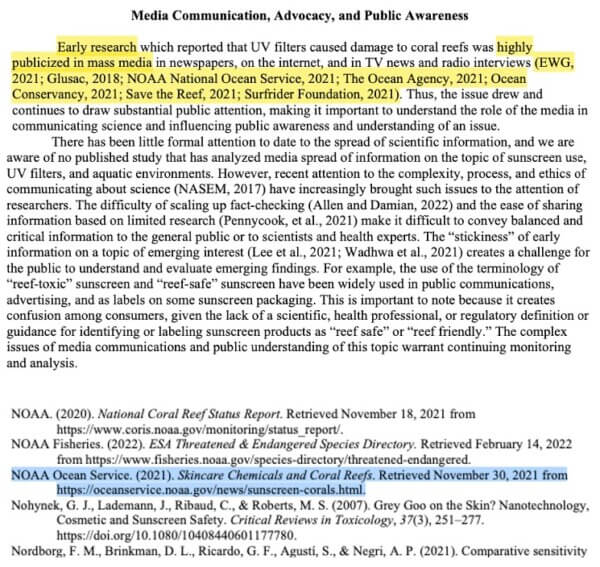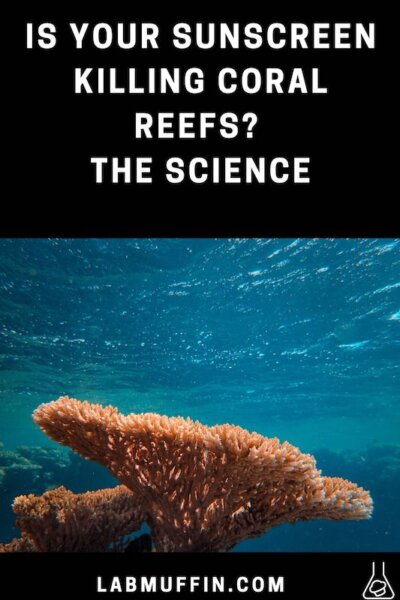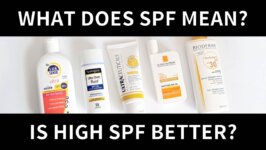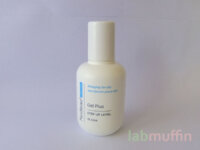You might have seen that Hawaii has banned certain sunscreens that have been linked to coral bleaching. In particular, it’s the organic “chemical” sunscreen ingredients oxybenzone and octinoxate that have been banned. It sounds like a great victory for the environment, right?
But if you search a little past the headlines, you’ll find that there are actually a lot of coral experts and marine ecologists who aren’t happy with the decision. Why is that?
To find out, let’s look at the science behind sunscreen and its effects on coral.
Check out the video here – keep scrolling for the text version.
What Is Coral Bleaching?
The concerns about sunscreen’s effects on coral come from studies on isolated coral samples, and the main possible impact is coral bleaching.
Coral live in symbiosis with algae (zooxanthellae) that live inside them. The algae are important to the coral because they absorb sunlight and photosynthesise to create nutrients to feed the coral. The algae are also responsible for the beautiful colours in coral.
But when the coral is overly stressed, it expels the algae, leaving the coral bleached and pale, and without their main source of food (algae provide about 90% of the coral’s energy). Bleaching is sometimes reversible, and if the stress is only temporary, the algae can return to the coral. But if the stress is prolonged or too severe, then the bleaching continues and the coral will eventually starve and die.
A lot of different stresses are known to cause coral bleaching. The main ones are temperature changes in water (usually as a result of climate change), ocean acidification, increased sunlight, and pollutants (e.g. herbicides and nutrients from farming, oil spills, silt).
Sunscreen and Coral Bleaching
Some sunscreen ingredients have also been found to cause coral bleaching in studies on isolated coral samples. The most studied filter is oxybenzone. Some of the key studies are:
- Danovaro et al. 2008:
- Hard corals bleached by octinoxate (1.98 ppm), oxybenzone (1.98 ppm) and 4-MBC (0.99 ppm)
- All other compounds tested (octocrylene (1.98 ppm), octisalate (1.65 ppm) and avobenzone (0.66 ppm)) had minor or no effects
- For non-sunscreening ingredients, butylparaben at 165 ppb caused bleaching, propylene glycol at 33 ppm had no effects
- Bleaching was worst when sunscreen exposure occurred at higher temperatures
- The ingredients could potentially cause coral bleaching by promoting viral infections
- (Concentrations of filters are slightly ambiguous in the paper; concentrations are per volume)
- Jovanović & Guzmán 2014:
- Titanium dioxide nanoparticles caused slight bleaching of stony coral at 0.1 ppm and 10 ppm
- Downs et al. 2016:
- Oxybenzone causes bleaching and deformities in multiple coral species at 2.28 ppb – 228 ppm
- The effect is worse in light
- Fel et al. 2017 (symposium presentation, summarised by Wood 2018):
- No effect from octocrylene, octyl triazone, ecamsule (Mexoryl SX) or drometrizole trisiloxane (Mexoryl XL)
- Avobenzone had an effect only at highest concentration tested (5 ppm)
- Zinc oxide had no effect at 10 ppb but caused bleaching at 1 ppm
- Corinaldesi et al. 2018:
- Uncoated zinc oxide nanoparticles caused rapid bleaching of stony coral at 6.3 ppm
- Coated/modified titanium dioxide nanoparticles had minimal effect at 6.3 ppm
- This suggests that it’s dissolved zinc ions that are harmful and not the formation of oxidising substances (like hydrogen peroxide), since it’s well known that titanium dioxide is more potent at forming free radicals in sunlight
Is there enough sunscreen in the environment to harm coral?
The studies listed above have led to the headlines that sunscreen ingredients can cause bleaching at “extremely low concentrations”. But there are still varying degrees of “extremely low” that are relevant here:
- ppm means “parts per million”, or milligrams per litre. This is the equivalent of one-fiftieth (1/50) of a drop diluted in one litre (around 1/4 gallon for you US people).
- ppb means “parts per billion, or micrograms per litre. 1 ppb is a thousand times more dilute than 1 ppm.
- ppt means “parts per trillion, or nanograms per litre. 1 ppt is a thousand times more dilute than 1 ppb, and a million times more dilute than 1 ppm.
These distinctions are important because, even though these numbers are tiny to us, they’re extremely important when working out the effects of sunscreens on coral relative to the amounts of sunscreen. The fundamental principle in toxicology is that everything can be a poison in large enough amounts, and everything is safe in low enough amounts. This is commonly summarised as “the dose makes the poison”.
In the studies, sunscreens were exposed to coral in the ppm to ppb range. And while these sound pretty low, other coral researchers have pointed out that these concentrations are much higher than those found in the vast majority of the environment.
For example, the lowest concentration of pure sunscreen filter used in the 2008 Danovaro paper that had an effect was 0.99 parts per million of 4-MBC (enzacamene), which sounds quite low – but it’s actually quite a lot.
Assuming that you applied 30 g (the recommended amount) of sunscreen containing 3% enzacamene on your entire body and it washed off completely into the water as you swam, you’d get that concentration if you swam in 909 L of water – about 3 bathtubs full.
To achieve 2.28 ppb of oxybenzone, the lowest quantity tested in the 2015 Downs study, your 30 g of 6% oxybenzone sunscreen would be diluted in 790000 L, or one third of an Olympic swimming pool.
These estimates are quite conservative, since it’s commonly found that people usually wear less than half of the recommended amount of sunscreen, and the amount that dissolves in water is far less than 100% (the 2008 Danovaro paper estimates that 25% of the sunscreen comes off in a 20 minute swim).
The ocean is also massive, containing 97% of the Earth’s water – 1.34 x 1021 L, which translates to 1.8 x 1011 L of water, or 70 thousand Olympic swimming pools for each of the 7.44 billion people who live on Earth. That’s also about 180 litres of water per grain of sand on Earth.
There are also ocean currents that carry away pollutants as they enter the water. So it shouldn’t be surprising that sunscreen is only found in almost undetectable concentrations in most of the environment (in the ppt range), or is undetectable.
But higher concentrations that realistically could affect coral have been found in some places, generally in secluded bays with hundreds of recreational swimmers in a small patch of water, like on popular beaches. For example, in Hawksnest Bay and Trunk Bay in the US Virgin Islands, concentrations of oxybenzone between 75 ppb and 1.4 ppm have been measured during busy times of the day.
It’s important to note that even though environmental concentrations are low, bioaccumulation can also occur. This is when the sunscreen ingredients build up in coral and lead to a higher concentration than in the water.
Estimated effects of sunscreen on actual coral
As well as the low concentrations, there’s another big question mark in the data. Unlike for other impacts on coral, there isn’t any solid evidence of sunscreens having caused harm to coral reefs.
There’s some anecdotal evidence from researchers who have seen that coral reefs in a few areas with more swimmers are more degraded than in areas with less swimmers, or with less sunscreen use – but anecdotal evidence is flawed, and there aren’t any studies with convincing evidence. This is very different from the headlines you might’ve read about how we’re all destroying coral with sunscreen!
In studies on sunscreen and coral, some researchers have tried to estimate the effects of sunscreen in the environment on coral:
- Tsui et al. 2014:
- In aquatic recreational areas in Hong Kong near snorkeling hotspots, it’s estimated that the risk of bleaching of hard corals by oxybenzone was 21% risk and by octinoxate was 11%
- Danovaro et al. 2008:
- An estimated 10% of the world’s reefs are threatened by sunscreen pollution
- However this frequently-cited conclusion might not be warranted due to their assumptions – they base it on the fact that 90% of tourists are concentrated on 10% of the world’s reefs, and they say that their conservative estimate is based on tourists applying an average of 2 mg/cm2 of sunscreen to their entire body twice a day, when most studies have found that people tend to apply less than 1 mg/cm2
A distraction from the real issues?
But a lot of researchers are of the opinion that the harm from sunscreen for the vast majority of coral reefs is actually minuscule, if you look at the bigger picture. Sunscreens don’t even rate a mention in recent textbooks and reviews on coral bleaching.
The much bigger threats to coral are climate change and agricultural management, and against these larger threats, banning sunscreens to save the reefs is a bit like rearranging deckchairs on the Titanic, or polishing a scratch on your doorknob when your house is burning down. It helps, but is it really worth doing?
- Coral expert Professor Terry Hughes, the director of the Director of the ARC Centre of Excellence for Coral Reef Studies (see his impressive publication record here) says he “would place sunscreen at number 200” on a list of negative human impacts on coral reefs. He points out that the worst bleaching is happening in places where tourists don’t go – for example, in the massive 2016 Great Barrier Reef bleaching event, the worst bleaching by far occurred in the remote Northern region, and correlates with the water temperatures that have been rising as a result of climate change. He’s also written a commentary that ends with the stark statement that “there is actually no direct evidence to demonstrate that bleaching due to global heating is exacerbated by sunscreen pollutants. Similarly, there is no evidence that recovery from thermal bleaching is impaired by sunscreens, or that sunscreens cause coral bleaching in the wild.”
- Researchers Kelvin Gorospe and Austin Humphries at the University of Rhode Island point out that damage from sunscreen “is negligible against the backdrop of what really is threatening reefs […] climate change”. They advise that “if you want to do something to help save not only coral reefs but the ocean in general, sunscreens should not be high on your radar”.
- Coral scientists Carys Mitchelmore and Doug Fenner state that they’re “perplexed by the misguided distraction that a limited and unreplicated study about one of the sunscreen chemicals (oxybenzone) is gaining, and [they’re] frustrated that it’s taking the spotlight off scientifically proven concerns to reef decline. People are being led to believe there is extensive scientific evidence about the impact of oxybenzone on corals, and this is simply not true.”
These scientists are also critical about the sunscreen ban – it seems to be an easy way for politicians to show that they’re “doing something” and distract from the bigger, harder-to-fix issues of climate change and reef management.
While it may help, it’s insignificant and most likely a disingenuous (or at least misguided) way for governments to avoid dealing with issues with far great corporate interests involved. There’s limited funding for addressing environmental issues, and attention on the wrong things can distort people’s perceptions.
We seem to be losing sight of the real problems (warming / emissions), with growing focus on straws and sunscreen = displacement behaviors = pointless little things we’re doing bc we don’t wanna accept the real challenge in front of us. https://t.co/CWdxHt0zAb
— John Bruno (@JohnFBruno) June 28, 2018
If trading the fight against the many drivers of climate change for ditching your sunscreen brand sounds too good to be true, it’s because it is. Important op-ed in @projo by @URI_fisheries PI @ATHumphries and post-doc @kdgorospe. https://t.co/XIphFhdm5b
— Humphries Lab (@URI_fisheries) June 28, 2018
Another tokenistic aside to lull is into a collective delusion of #OceanOptimism and distract us from the real challenge of mitigating climate change, addressing which unsettles corporate mentality and related political camps as threatens ‘business as usual’
— Peter JS Jones (@PJSJones) May 27, 2018
What Can You Do?
Avoid harmful sunscreens if you’re swimming near coral
Sunscreen has pretty negligible effect, except perhaps if you’re planning to swim in an area close to coral. In those situations, you should try to maximise your use of other types of sun protection (shade, sun-protective clothing) so you can minimise your use of sunscreen. For the exposed areas, look for sunscreens that don’t contain ingredients that have been found to be harmful to coral, or contain lower amounts.
Common sunscreen ingredients:
- Harmful: oxybenzone, octinoxate, enzacamene (4-MBC), zinc oxide
- Minimal harm or no effect: octocrylene, octisalate, avobenzone, octyl triazone (Uvinul T), ecamsule (Mexoryl SX, drometrizole trisiloxane (Mexoryl XL), titanium dioxide
- Unknown: bemotrizinol (Tinosorb S), bisoctrizole (Tinosorb M), diethylamino hydroxybenzoyl hexyl benzoate (Uvinul A Plus), ensulizole, homosalate
Some safe sunscreens:
- Stream2Sea SPF 30 Sunscreen
- Cancer Council Ultra SPF 50+ Sunscreen
- La Roche-Posay Anthelios Activewear Lotion Sport Sunscreen
- Headhunter Sunscreen SPF 50
- Supergoop! Everyday Sunscreen SPF 50
- Coppertone Sport Sunscreen Lotion SPF 50
It’s important to make sure you read the actual ingredients of the sunscreen, and don’t just look for labels like “reef-friendly”, “biodegradable” and “non-biodegradable”. Lots of “reef-friendly” sunscreens mistakenly assume that organic (“chemical”) sunscreens are harmful while inorganic (“mineral”) sunscreens are safe, even though zinc oxide has been found to be worse for coral than many “chemical” sunscreens, and some even contain oxybenzone.
Note on zinc oxide: Zinc oxide is toxic at around the same concentrations as the organic sunscreens (except oxybenzone), but it’s typically used at much higher levels in sunscreens (up to ~25% zinc oxide vs. below 10%/closer to 5% for organic filters). And although only zinc oxide nanoparticles were tested in the published studies (the particle size used in the Fel study is unknown), it’s possible that “non-nano” micronised zinc oxide will have this effect too (depending on how the zinc comes into contact with the coral) – one paper suggests that it’s to do with dissolved zinc ions, and both micro- and nano-zinc oxide release similar amounts of zinc ions.
Biodegradable also doesn’t mean reef-safe – both zinc oxide and titanium dioxide are non-biodegradable (again, they are often mistakenly labelled as “biodegradable” even though they don’t break down), but one is harmful while the other is relatively safe.
To minimise the amount of sunscreen that washes off your skin, choose sunscreens with high water resistance and apply them 20 minutes before you enter the water.
Act on climate change
More importantly, you can try to help with climate change. While climate change is a huge and scary problem, there are are a few things you can do to try to help:
- Cut down on the biggest contributors to your personal carbon footprint: for most people, these are driving cars, going on long-haul flights and eating meat.
- Opt for a green energy provider
- Vote for political parties who recognise climate change as a threat, and whose policies address the problem
- Contact your local representatives about climate change. If you feel like your voice isn’t heard, it might make you feel better to know that because most people stay silent, they assume that one opinion represents the views of multiple people.
National Academies report
Update: 23 August 2023
The National Academies released a 400 page report that goes through the existing data on the environmental impacts of sunscreen in August 2022: Review of Fate, Exposure, and Effects of Sunscreens in Aquatic Environments and Implications for Sunscreen Usage and Human Health
The report points out that there are many data gaps, and highlights that highly limited studies like the Downs study should not be the basis of policy changes. It also points out that the existing data shows that organic (chemical) and inorganic (mineral) sunscreens have overlapping toxicities, i.e. mineral sunscreens aren’t “reef-safe”. I’ve gone into a bit more detail on the data in this post on environmental claims.
Related post: Natural ingredients aren’t actually better for the environment
NOAA page: “Skincare Chemicals and Coral Reefs”
Interestingly the report explicitly refers to a page on the NOAA website titled “Skincare Chemicals and Coral Reefs” that many people have been citing as evidence that sunscreen harms coral reefs. It has a laundry list of poorly supported claims about sunscreen ingredients harming wildlife, and which ingredients to avoid. In the National Academies report, this page is listed alongside the EWG, Save the Reef and Surfrider Foundation as an example of a source that publicised “early research” (i.e. the Downs study), making it “a challenge for the public to understand and evaluate emerging findings”. It’s on page 178.

The NOAA page was updated on 17 August 2022 with this statement: “NOAA is reviewing the study and, upon completion of this review, will update the information presented in this article as warranted.” As of 23 August 2023, it still hasn’t been updated…
Update: 6 June 2025
I emailed NOAA about updating their page in June 2024. To my surprise, the Coral Reef Conservation Program Communications Director emailed me back to let me know they updated the page with the following:
Scientists have also discovered that some of the chemicals found in sunscreen and other personal health products threaten the health of coral reefs. How these, and other compounds, affect reef ecosystems remains an active area of research. In August 2022, the National Academy of Sciences released a study which reviews the state of the science on the use of sunscreen ingredients and their environmental impacts. Overall the study found that specific (chemical) UV filters found in chemical sunscreen can harm aquatic life, including corals, and therefore, a more comprehensive ecological risk assessment of all UV filters in chemical sunscreen is needed. Mineral sunscreen, which does not use (chemical) UV filters, is considered a better option because there are less effects to aquatic organisms. Wearing UV protective clothing, like sun shirts and pants, is also a great option.
The infographic, in all its egregious glory, remained. According to her LinkedIn, the communications director has a MSc in marine biology, and should be capable of reading. So I replied with page references:
Thanks for getting back to me – I was wondering which parts of the National Academies report found that mineral sunscreens were a better option and had less effects on aquatic organisms? My reading of the study is that the effects depend on the specific sunscreen ingredient, and that mineral sunscreens have greater effects than many chemical sunscreens – this is also the interpretation presented by some of the authors at recent talks.
For example:
p 161: “Finding: Acute toxicity has been observed under 1,000 μg/L for dioxybenzone, octinoxate, oxybenzone, padimate O, TiO2 (in the presence of UV radiation), and ZnO and in a few studies for avobenzone and octocrylene. In addition, QSAR estimates for aminobenzoic acid, cinoxate, meradimate, homosalate, and octisalate suggest possible toxicity below 1,000 μg/L. Toxicity values typically exceed solubility for the poorly soluble UV filters (solubility under 100 μg/L).”
p 139: “Based on acute data, organic and inorganic UV filters completely overlap with respect to acute toxicity.”
This is also illustrated in many of the figures in Chapter 6, where the LC50s for zinc oxide / titanium dioxide are lower than many chemical sunscreens.
Table 8.1 (p 186-189) actually shows more concerns for mineral sunscreens than many chemical sunscreens, where there is sufficient data.
The study also disagreed with a lot of the other text of that page and the infographic, e.g. p 148-149 shows that nano and bulk ZnO have similar impacts, since the main toxic species is dissolved Zn2+.
She replied:
Those are all good questions. Please contact the study authors to better understand the results and to discuss these questions you have.
If we need to amend the text on the website to better reflect our understanding of recommendations for sunscreen use, beyond the NAS study, we can do so. The last two sentences provide suggested alternatives to chemical sunscreen but isn’t referencing the NAS study. I can work with some of our colleagues to better communicate what the infographic is saying and what recommendations we can provide on sunscreen use.
Because I’m annoying, I replied:
Can I confirm that the NOAA believes that this is an accurate interpretation of the National Academies study before I contact the study authors?
“Overall the study found that specific (chemical) UV filters found in chemical sunscreen can harm aquatic life, including corals, and therefore, a more comprehensive ecological risk assessment of all UV filters in chemical sunscreen is needed.”
The reply:
“The NAS study has certain high level conclusions and recommendations. I suggest you speak with the study authors on that.”
To me, this seems wildly unscientific and irresponsible. As the National Academies report details, this type of misinformation can lead to real increases in health harms, with no likely environmental benefit. I suspect this may have to do with the NOAA-affiliated co-author on the Downs paper, who is also the godmother of his child. On the bright side, it seems that the National Academies report’s negative assessment of the NOAA page is still valid.

References
Corinaldesi C et al., Impact of inorganic UV filters contained in sunscreen products on tropical stony corals (Acropora spp.), Sci Total Environ 2018, 637–638, 1279–1285. DOI: 10.1016/j.scitotenv.2018.05.108
Danovaro R et al., Sunscreens cause coral bleaching by promoting viral infections (open access), Environ Health Perspect 2008, 116, 441–447. DOI: 10.1289/ehp.10966
Downs C et al., Toxicopathological effects of the sunscreen UV filter, oxybenzone (benzophenone-3), on coral planulae and cultured primary cells and its environmental contamination in Hawaii and the U.S. Virgin Islands, Arch Environ Contam Toxicol 2016, 70, 265–288. DOI: 10.1007/s00244-015-0227-7
Gorospe K & Humphries A, To lather or not to lather? Providence Journal, 27 Jun 2018 (accessed 29 July 2018).
Gregory K, Hawaii bans sunscreens with chemicals that damage coral reefs, but Australia reluctant to follow, ABC News, 4 May 2018 (accessed 29 July 2018).
Jovanović B & Guzmán HM, Effects of titanium dioxide (TiO2 ) nanoparticles on caribbean reef-building coral (Montastraea faveolata), Environ Toxicol Chem 2014, 33, 1346–1353. DOI: 10.1002/etc.2560
Tsui et al., Occurrence, distribution and ecological risk assessment of multiple classes of UV filters in surface waters from different countries, Water Res 2014, 67, 55–65. DOI: 10.1016/j.watres.2014.09.013
Wood E, Impact of Sunscreens on Coral Reefs (open access), International Coral Reef Initiative, 2018.
This post contains affiliate links – if you decide to click through and support Lab Muffin financially (at no extra cost to you), thank you! For more information, see Disclosure Policy.






Great article! Love that you suggest meaningful action. I am very weary of “ecological” travel blogs suggesting you pack some reusable straws on your long-haul vacation.
Thanks Michelle, a really good read! We’ve been talking a bit about coral-safe sunscreens in my KB community this summer, so I’ll share this article with them.
Excellent post. Folks really need to be aware of “greenwashing” !
Fantastic article – the ban does smack of political tokenism so government is “seen” to be doing something. Can I add to your suggestions of things people can do: Be aware and informed about native vegetation clearing (big issues in NSW, Qld &WA due to mining and intensive beef farming). Intensive beef farming also requires intensive use of herbicides and pesticides to grow crop fodder which ends up in ground water, rivers, wetlands and oceans).
That’s a good point! Are there any good resources you’d recommend on practical steps we can take to help with those issues?
Thank you for this well-written article and the well-made video. I am annoyed with the fear mongering and the perspective that is based on either no science or very distorted, cherry-picked information masquerading as science. I do think that most people want to do what is best for them, for others and for the environment. But we should not be satisfied with quick fixes, or acting based mostly on the preference for emotion, belief and opinion over science and evidence, and spending less time and effort understanding the issue and getting more information. Sadly, that is what I see a lot of well meaning persons do.
“acting based mostly on the preference for emotion, belief and opinion over science and evidence” – That’s a really good way of phrasing it! I’ve gotten into a lot of arguments with people who tell me to stop saying that organic is not everything it’s cracked up to be, because it “discourages people from being more conscious with their consumption”.
What about coated zinc oxide? Would its effects be more comparable to that of coated titanium oxide than of uncoated zinc oxide?
I don’t think there’s any data on that yet unfortunately!
Thank you for your reply! So much is still unknown. Thank you for your guidelines on how to better help the environment.
Thank you very much for the effort you put into this post. As someone who lives on a sailboat, sunscreens vs. coral reef bleaching is an important topic to me, since all of my wastewater goes straight into the ocean.
I also really appreciate your perspective on the fear-mongering side of sunscreen ingredients. My sunscreens are all what I’d call “reef safe,” but the focus on sunscreens truly does distract from the bigger picture of coral reef damage.
I’m in Germany, don’t live near any corals nor do I swim in the sea, so I have always been baffled by the “coral-safe” marketing that’s common here for sunscreens too. I was even wondering whether my wastewater from washing sunscreen off my face would eventually reach the southern oceans… because why else would companies use this marketing, if it wasn’t relevant to us? This really creates some insecurities but your article really helps with that. Thank you for looking into this!
Considering my knowledge of chemistry I kept on scratching my head for a while to wonder how Zinc O is biodegradable. I could not find an answer. It is a mineral so it is going to deposit and accumulate unless you add something like acid to react with it and then it will change its form. Everywhere they can Zinc O bio-degradable. What a misinformation! Thank you for clearly stating that it is not.
thank you for this!
the only daily face lotion I can tolerate has octinoxate and zinc (Olay Complete for Sensitive Skin– in the U.S.). it doesn’t cause a reaction on my sensitive skin, and it doesn’t feel greasy at all. it’s so affordable too! it’s not formulated for swimming, so I don’t think this one is even a threat to coral. but I’m worried that bans in some states or countries will cause bans of the chemical overall.
It’s worse than just rearranging the deck-chairs on the Titanic…
We have a long, sordid history of enacting environmental legislation and agendas aimed at consumer-behavior whilst entirely letting mega-scale manufacture and industrial entities off the hook. We did this with the “paper or plastic?” false dichotomy in the 1980s, with “don’t litter” campaigns and consumer-shaming after the advent of single-use plastic soda and water bottles and we’re doing it now. Corporate Lobby groups actually PUSH for this type of legislation because it’s massively profitable to toss their wildly destructive exploitation of the planet entirely off the table whilst attacking the folks who are least-empowered to make any changes to the way they do business. And on top of it all, they get to claim tax-deductions for funding their “environmental improvement” arm of the business, claiming that by penning legislation, paying these lobbyists and paying for education (propaganda) materials, they’re doing GOOD.
Here’s a tweet that sums up how consumer behavior is not the problem here:
https://x.com/BontanUK/status/1478712482189524993?s=20
Thank you for this, I have a lot of environmental guilt and need reminders that placing blame on the individual is a marketing tactic to deflect from the corporate practices at the heart of climate change.
That said, I’m visiting Hawaii and will be swimming in areas close to coral and off of beaches that are “high-traffic”. I was planning on buying Stream2Sea’s mineral sunscreen instead of Bondi Sands, but if zinc oxide may not be safer than avobenzone & homosalate I’m not sure I want to make the leap from a sunscreen that works for me. I also want to be respectful of the ban, regardless of its origin, as a tourist whose dollars contribute to the problem.
Basically I am stuck in analysis paralysis. Are the “safe” sunscreens listed here also effective sun protection? Thoughts and suggestions are much appreciated for this US consumer with limited filter choices!